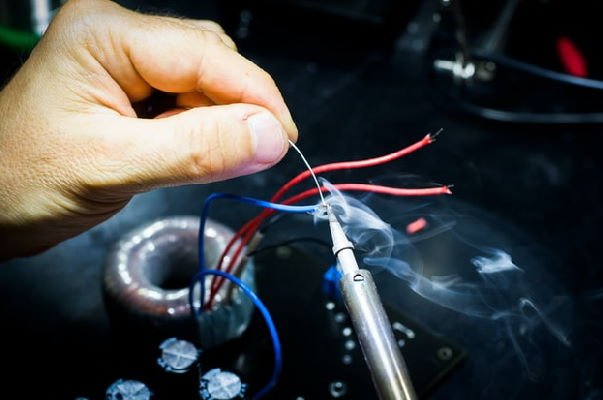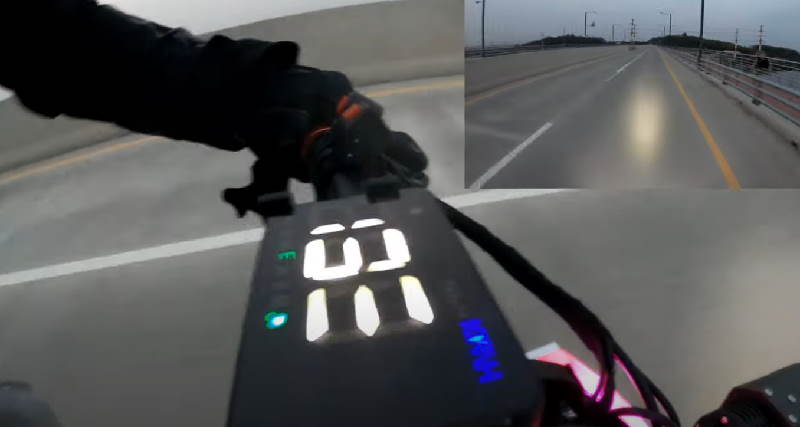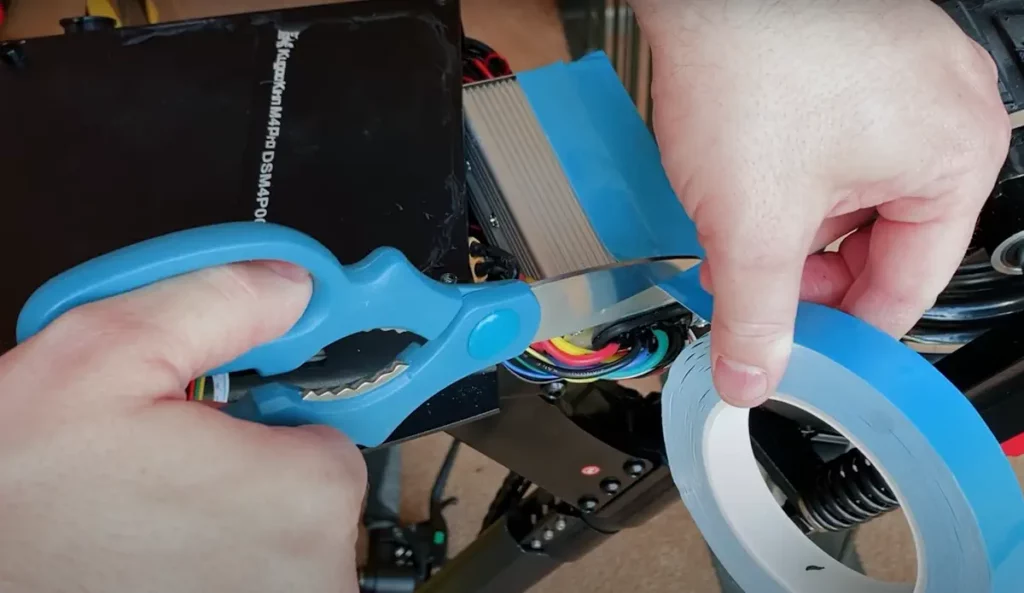While not as expensive as a few years ago, electric scooters are still a substantial investment for most people.
We all want high-quality products that last, and we hate to have to get a new product after a few weeks. This research provides the exact answers on how long electric scooters last.

How long do electric scooters last?
One in every three scooters will last at least two years. Most scooters (including budget models) will last more than a year, but rarely more than three. One in 6 scooters will last 5 years or longer. Higher-end scooters can often last longer than 5 years.
Let’s take a deep dive into the data that provided these answers, and see which scooters are the most reliable and how long they last.
Research
We used Amazon review data for the following popular electric scooter models:
- Ninebot Max
- Xiaomi M365
- Glion Dolly
- Ninebot ES1
- Swagtron Swagger 5
- Razor E300
- Razor EcoSmart
- Uberscoot 1600W
Most of these scooters are in the same price category. They all cost between $300 and $500, except for the Uberscoot 1600W and the Ninebot Max, which often cost around or below $800.
That means we are mostly looking at budget scooters. Higher-end models will have even better lifespans, of course, but since they are not selling that many units, the data on their lifespans will not be statistically relevant.
How many electric scooters break down in the first year?
These scooters have collectively sold over 571,300 units, with 25% of owners reporting serious malfunctions on Amazon.
The table below shows negative reviews where scooters stopped working shortly after delivery or arrived defective.
These reviews make up a significant portion of the negative feedback and include details on when the defect occurred, the reason, and the number of occurrences.
| Time of defect | Reason | N. of instances |
| Dead on arrival | App | 5 |
| Dead on arrival | Battery | 8 |
| Dead on arrival | Brakes | 2 |
| Dead on arrival | Charging or charger-related | 9 |
| Dead on arrival | Controls or controller | 10 |
| Dead on arrival | General or unknown | 39 |
| Dead on arrival | Mechanical | 2 |
| Dead on arrival | Stem and folding | 2 |
| Very little use (< 1 month) | App | 3 |
| Very little use (< 1 month) | Battery | 20 |
| Very little use (< 1 month) | Brakes | 7 |
| Very little use (< 1 month) | Charging or charger-related | 8 |
| Very little use (< 1 month) | Controls or controller | 4 |
| Very little use (< 1 month) | General or unknown | 44 |
| Very little use (< 1 month) | Mechanical | 7 |
| Very little use (< 1 month) | Stem and folding | 6 |
| Less than 6 months | Controls or controller | 3 |
| Less than 6 months | General or unknown | 14 |
| Less than 6 months | Battery | 6 |
| Less than 6 months | Brakes | 2 |
| Less than 6 months | Charging or charger related | 7 |
| Less than 6 months | General or unknown | 11 |
| Less than 6 months | App | 1 |
| Less than 6 months | Stem and folding | 11 |
| Less than 6 months | Mechanical | 14 |
| Less than 6 months | Battery | 10 |
| Less than 6 months | Controls or controller | 3 |
| Less than 12 months | Battery | 9 |
| Less than 12 months | General or unknown | 8 |
| Less than 12 months | Mechanical | 1 |
| Less than 12 months | Stem and folding | 3 |
There are a total of 279 defects that have rendered the scooter unusable or unsafe for further use.
Furthermore, 176 of these scooters arrived with serious defects or developed defects shortly after initial use. In over half of these cases, owners quickly identified the issues and requested returns or replacements.
These are the defects, presented in order of frequency:
- General or unknown – 116 (scooter didn’t start, didn’t run, stopped working, or not specified)
- Battery – 53 (battery or battery-related components were the known cause for defect)
- Mechanical problems – 24
- Charger or charger related – 24
- Stem, folding, or handlebar – 22
- Controls or controller – 20
- Brakes – 11
- App – 9
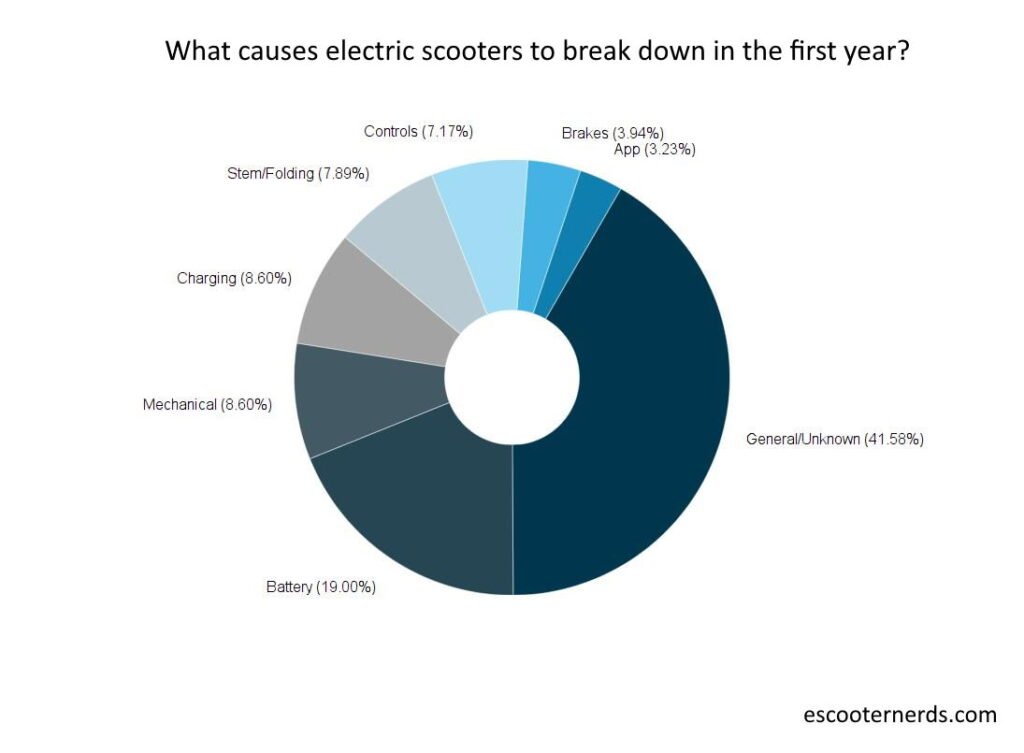
This table represents the number of reported defects and the defect rate for every scooter model in the first year.
| Electric scooter | N. of reviews | Units sold (est) | N. of defects | Dead on arrival or after short use | Defect rate |
| Xiaomi M365 | 1938 | 290700 | 110 | 72 | 5.68% |
| Ninebot ES1 | 177 | 26550 | 6 | 3 | 3.39% |
| Ninebot Max | 664 | 99600 | 32 | 27 | 4.82% |
| Swagtron Swagger 5 | 305 | 45750 | 28 | 22 | 9.18% |
| Razor E300 | 1243 | 186450 | 56 | 28 | 4.51% |
| Razor EcoSmart | 697 | 104550 | 27 | 14 | 3.87% |
| Glion Dolly | 613 | 91950 | 18 | 9 | 2.94% |
| Uberscoot 1600W | 76 | 11400 | 2 | 1 | 2.63% |
| Total/Average | 5713 | 856950 | 279 | 176 | 4.63% |
This is a visual representation of the defect rates.

The defect rate should consider the total units sold rather than just the number of reviews. This adjustment is essential because defects in the first year are more likely to result in one-star reviews. Therefore, the actual defect rate is much lower than the numbers suggest.
This is the average defect rate in the first year. It is quite reliable for a complex product like an electric scooter. Electric scooters have a 95.37% chance of lasting at least one year after purchase without a serious defect.
How long do electric scooters last?
The previous data set addressed the opposite of this question, which is how fast can scooters stop working.
This is a bit more difficult to measure. The reason for that is three-fold:
- we can only know how long a scooter lasts after it breaks down completely
- most electric scooters have not broken down completely yet, and will probably not do so in the short term
- very few people leave reviews, and even fewer leave reviews when a product works as it’s supposed to
This means we can only partially answer this question.
Excluding newer listings like the Swagtron Swagger 5, Ninebot ES1, and Ninebot Max, we focus on 4 and 5-star reviews older than 6 months for reliable data.
These reviews generally indicate that the scooters have lasted from the time of purchase up to the present, as users tend to change reviews to one-star if issues arise.
| Electric scooter | Total Reviews | Total 4 or 5 stars | 4 or 5 stars, > 6 months | 4 or 5 stars, > 1 year | 4 or 5 stars, > 2 year | 4 or 5 stars, > 3 year | 4 or 5 stars, > 4 year | 4 or 5 stars, > 5 year |
| Xiaomi M365 | 1938 | 1124 | 56% | 38% | 10% | no data | no data | no data |
| Razor E300 | 1243 | 908 | 73% | 70% | 66% | 53% | 39% | 26% |
| Razor EcoSmart | 697 | 572 | 64% | 47% | 38% | 30% | 22% | 19% |
| Glion Dolly | 613 | 484 | 63% | 37% | 18% | 9% | 5% | no data |
| Uberscoot 1600W | 76 | 63 | 57% | 29% | 13% | 3% | 3% | 3% |
| Total/Average | 4567 | 3151 | 62.6% | 44.2% | 29% | 23.75% | 17.25% | 16% |
Here is a visual representation of the averages from the table above.

From the data set above, we can draw the following conclusions:
- even budget scooters have at least a 62.7% chance of lasting more than 6 months
- there is a minimum chance of 44.2% that an electric scooter will last at least one year
- at least 29% of scooters last more than two years
- at least 24% of scooters last more than three years
- at least 17% of scooters last 4 years or more
- 16% of scooters can last longer than 5 years
However, these are the bare minimums.
Anecdotal evidence, experience, and simply checking out electric scooter communities, will lead us to conclude that the actual numbers are much better than these minimums.
What is the most reliable electric scooter?

Initially, we may think that the most reliable scooter should be the one with the lowest defect rate. That would mean that the Uberscoot 1600W is the most reliable scooter.
However, the problem here is that we don’t have as much data about this scooter. It has the fewest reviews out of all the models.
Don’t get me wrong, the Uberscoot 1600W is an excellent scooter! It is, in fact, very reliable. It is also one of the more expensive scooters on this list, and there is a good reason for it, as it is also the best-performing scooter on this list by far.
All in all, the Uberscoot 1600W has a lot of great things going for it. With an estimated number of units sold at 11400 and a low defect rate in the first year, it is one of the best inexpensive scooters you can ever buy.
Where to buy the Uberscoot 1600W from?
However…
To be confident that we have the most reliable scooter ever, we need to look at the models for which more data is available.
And so, we arrive at our champion.
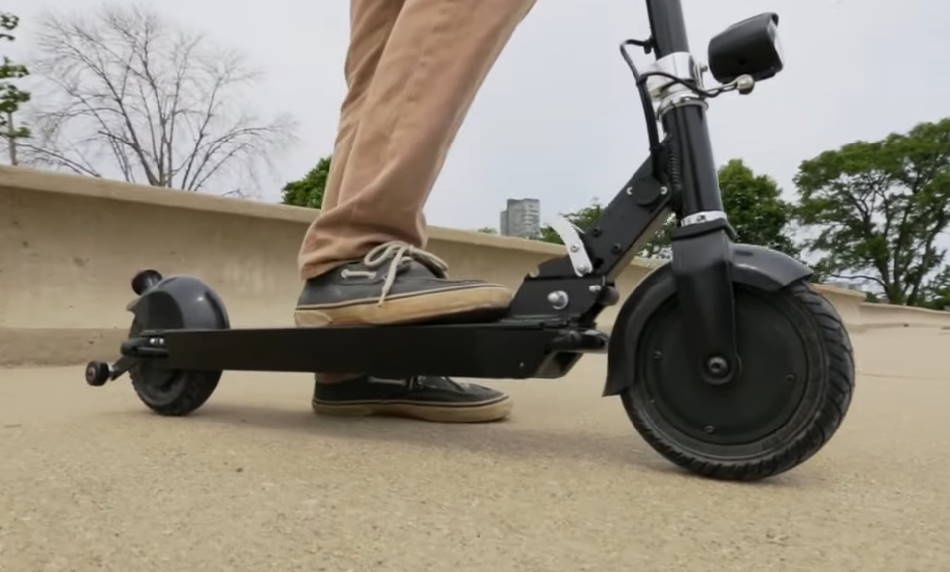
The most reliable budget electric scooter in the world today is the Glion Dolly. With an estimated 91950 units sold, a defect rate of just 2.94% in the first year, and a very strong chance that it will last more than 3 years, it earns the title of the most reliable scooter.
The methodology used for this research
Since we can’t obtain perfect and complete data for this research, we have to rely on partial data and a few assumptions. That will come at the cost of some precision, but it still gets us one step closer to answering the question of how long electric scooters last with a reasonable degree of confidence.
We rely on Amazon reviews for our research because they provide a substantial number of impartial and honest reviews. Amazon, being the largest online store globally, heavily depends on the accuracy and authenticity of these reviews, ensuring they are trustworthy and unbiased.
To clean the data, we only look at reviews from verified buyers.
One major problem is that we only have sufficiently large datasets for fairly new scooters.
As we demonstrated, we have two variations of the variable (Amazon reviews).
One is the number of 4-star and 5-star reviews. These are the owners that have had no issues, or only minor issues with their scooters. We only look at reviews that are 6 months old or older, which reduces the number of owners to those who’ve only had the scooter for a significant amount of time. Then, we multiply the number of reviews by the quotient of the total number of reviews, and the number of 4-star and 5-star reviews, which will take into account people who have left positive reviews without a comment, but still keep in mind the proportion of the time intervals.
The other data group we look at is the number of people who have left 1-star and 2-star reviews and have also stated that their scooter has become unusable or no longer safe to ride. We also note the reason for the defect. The standard error in this data will be that not every serious defect is reported on Amazon, but we can be pretty certain that serious malfunctions are reported and punished with 1-star reviews, probably far more often than ideal performances are rewarded with 5-star reviews.
We will be somewhat hard on electric scooter brands here and go for the worst assumption, assuming that only a quarter of the serious defects have been reported.
That very likely makes this data skewed toward negative reviews.
We will work under the assumption that between 0.5% and 1% of customers leave reviews (source). Using that percentage, we will estimate the total number of units sold on Amazon.
That number, together with the data, will provide the answers we are after.
Sure, here’s a revised version:
Check our video below showcasing the top 10 electric scooters with the longest range.
Worst electric scooters
This study looked at the total number of defects but it didn’t group and intersect them based on the defect type and the scooter type and model. See my research on electric scooter defects for a more in-depth look at the most common serious scooter problems and malfunctions, and which models have them the most.


